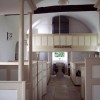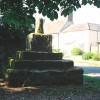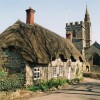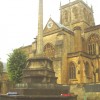“Goodnight, everybody, goodnight”
This mellifluous farewell would have been familiar to those with radios tuning in to the then Home Service of the BBC during the post-war years. The “Golden Voice” belonged to Stuart Hibberd, one of the earliest celebrity broadcasters of the Corporation’s early and intermediate periods, who with his friend and fellow Dorsetman Ralph Wightman set an example of a standard in radio presentation, which has now largely lapsed. By the time of his death in November 1983 at the ripe old age of 90, Hibberd could look back on an illustrious career, and one not without its firsts in the field of radio.
Stuart Hibberd was born in the east of the county into a Broadstone family in 1893, and educated at Weymouth College, from where he won a choral scholarship to St. John’s College, Cambridge. On the outbreak of war in 1914 he joined the Dorset Regiment, going on to serve with distinction in the Gallipoli campaign and also with the army in India.
Having survived the war he passed a somewhat aimless and obscure five years, during which time, in 1923, he married Alice Chichester, daughter of Lt Col Gerard Chichester, a senior officer of his former regiment. But the following year Hibberd’s big break came. Spotting a newspaper advertisement placed by the just two-year-old BBC for a Broadcaster/Announcer, he applied for the job and was accepted. Despite being a rural Dorsetian the successful candidate possessed one excellent credential he spoke RP (received pronunciation) which stood him in good stead when he was engaged to fill the announcer vacancy at the then headquarters of the BBC at Savoy Hill.
At this London station Hibberd was soon promoted to Chief Announcer. With impeccable annunciation, his voice soon became the best known on the airwaves. Hibberd was one of the very earliest of the radio newscasters, at a time when the transmission of bulletins was not allowed before 7 p.m. When live outside broadcasts of dance music were begun in the mid 1920’s the studio microphone was fitted with a cut-out switch to prevent dancers from relaying illegal adverts or messages to friends.
The General Strike of 1926 burdened Hibberd and his colleagues with additional responsibilities, as newspapers were not being printed, compelling the public to rely on the BBC for all special news of the stoppage. The Savoy Hill station had to be put under heavy police guard, which was maintained there throughout the ten days of the strike. Because of the extra news, bulletins had to be extended, and senior staff was brought in to help. One rather curious stipulation the BBC made at this time was that all announcers had to wear dinner jackets. Stuart Hibberd did not object to this ruling, but nevertheless hated the tight collars and stiff, short cuffs, which creaked when he was reading on the air!
In March 1932 the Broadcasting House building in Portland Place became operational, and Hibberd made broadcasting history on the 13th by reading the first news bulletin ever transmitted from the Corporation’s new home. The 39-year-old broadcaster initially found the building depressing, though this in no way hampered his professionalism. Few in the media would have been surprised when in 1935 at the age of 42 Hibberd was awarded the MBE for his services to radio.
The Second World War inevitably brought about something of a seismic shift in the BBC’s operations and scheduling, which included the start of regular midday news bulletins. In April 1940 Hibberd was transferred for a while to the BBC’s station at Bristol. Here, he and his colleagues became closely involved with the news flooding in from the many theatres of war and were – by proxy- an indispensable part of the war effort on the home front. Possibly to avoid the stigma of being a non-combatant “reserved occupationists” Hibberd served in the Home Guard in his out of work hours until July 1942, when he was able to return to Broadcasting House. With the slow return to normality after the war, the BBC ventured into new broadcasting territory with shows such as Tommy Handley’s ITMA; Hibberd himself took part- and sang- on Children’s Hour from time to time.
During these years too, Hibberd’s thoughts and philosophy about what made good broadcasting practise crystallised in his mind. Like all experienced broadcasters he was conscious of the importance of writing for the voice, as distinct from the printed page. This had been realised in the early days of radio, when a special technique had to be contrived. But Hibberd went further: he founded a blueprint or guide to good presentation for his successors to follow. For example he advocated that broadcasters should avoid long sentences and instead script those which slide easily off the tongue. Phrases like: “the Soviet & Finnish State” or “extraordinary orderliness of the room” should be avoided. Hibberd also eschewed parentheses, believing their use should be kept to a minimum because of the difficulty in making meanings clear, and the need to vary intonation of the voice.
For their retirement Stuart and Alice made their home in Devon, where sadly Alice died childless in 1977. Stuart always maintained close ties with his native county, and was elected Vice President of the Society of Dorset Men, a position he held for the rest of his life. His book ‘This is London’ is an autobiographical reminiscence of his experiences over 26 years of his broadcasting career and his fond memories of the many personalities he met in this capacity. Referring to the programme broadcast on Christmas Day 1946, he wrote “…the outstanding performance was given by Ralph Wightman, who introduced a man named Cross from Dorchester; he was so homely and sincere in his approach, and forthright too, that I felt very proud of my native county.”
Of Stuart Hibberd himself, it was remarked that he was unusually tall for his time, one of the loftiest men to walk the BBC corridors. He was kindly and courteous, but reticent, and modest enough never to seek fame or accolades, but was always popular with the public and colleagues.
NB: In May 1957 Stuart Hibberd was featured on ‘This is Your Life.’



